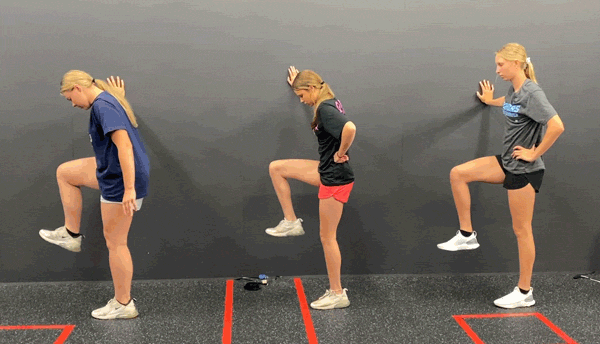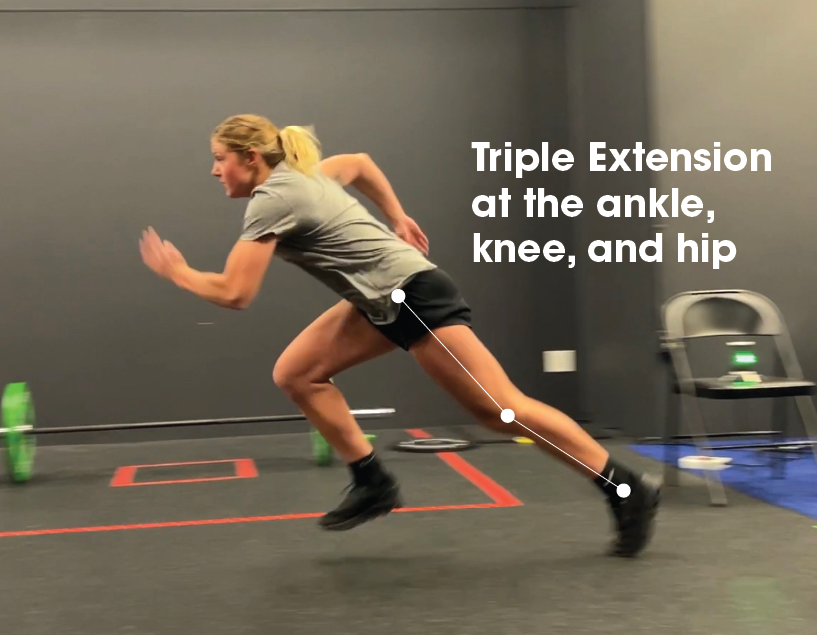Soccer players: Improve your speed with 9 drills & training best practices
If you’re a soccer player that wants to get faster on the field, then you’ve come to the right place.
This is not meant to be a comprehensive guide for the end-all-be-all of improving speed. A qualified sports performance coach (Hey, that’s us!) can help athletes advance more efficiently and effectively through mechanics work and an appropriate strength and conditioning program. But this article this will give you a great place to start if you are just beginning your journey.
When we say “speed” in this article, we are referring to the ability of an athlete to move from one point to another in a straight line as fast as possible, aka, linear speed. Today, we aren’t talking about skilled speed with a ball or speed combined with agility.
4 Keys to Speed Training
A good strength and conditioning program includes more than just lifting weight— explosive movements, plyometrics, and mobility work are a must.
1. A good strength and conditioning program
This might catch you by surprise, but strength training is foundational to getting faster. Athletes that work with a qualified strength and conditioning coach will improve the amount of force they can push into the group as well as the among of force they can absorb. It’s important that a strength training program includes explosive movements, plyometrics, and mobility work to better prepare the body to produce and absorb force.
… And this program shouldn’t be limited to just strengthening the lower body, but rather the whole body— improving how the body bends, moves, and works together.
Strength training has a large performance impacts during a game, and it is a major key in reducing the chance of injury. You know how bigger engines produce more power? That’s the idea— you need to build engine.
Interested in learning more about how youth athletes build power? Power Up ⚡️: A Parent's Guide to Training Power
2. A generous work-to-rest ratio for speed work
This claw drill is a great one for isolating sprint mechanics.
To build speed, we should be targeting the Phosphagen (5-10sec) or Fast Glycolysis energy system. This video from the NSCA explains the basics on human energy systems. These energy systems use up to 30 seconds of work with anywhere between 3 to 20 times that for additional rest.
At our facility, we use a 1-to-6 work to rest ratio at the minimum. So, if an athlete sprints for 5 seconds, they get a minimum of 30 seconds to rest before sprinting again. This kind of rest ratio best benefits developing top-end speed. If you shorten the rest, you’ll start moving into a different energy system and be performing conditioning work, which would work on the repeatability of speed.
A generous work to rest ratio most important thing to implement when doing top-end speed work. Anything else isn’t helping tune that engine as efficiently.
3. Technical skill work
Showing how three joints (ankle, knee, and hip) work together to produce force.
Speed is a skill, not just genetics. Athletes can become more efficient at speed by practicing technique— this makes the most out of the athlete’s speed potential. There is too much to cover about sprint mechanics than what we can do in this article, but working with a qualified coach is the best way to identify what mechanical issues need to be improved. Every athlete is different.
If you want a heads up on how we coach acceleration, head over to our “Speed Kills: The First Step to Getting Faster.”
4. Measure everything!
You don’t know if your improving (or the opposite!) unless you are measuring your performance. Laser timing systems are 99% accurate and much better than hand timing, but hand timing can be effective as long as you’re doing it the same way each time.
What kind of sprint work is most effective for soccer players?
Sprinting both short distances and long distances in training can be effective at developing top-end speed.
A recent study published in Biology of Sport examined the impact of both styles of sprint training on max sprint times between 5 meters and 40 meters (1). A cohort of U19 male soccer players were divided into two training protocol groups over 6 weeks.
Here’s what their training progression looked like ⬇️
The two different training plans — from “Effectiveness of short vs. long-distance sprint training on sprinting and agility performance in young soccer players” in Biology of Sport Vol. 41 No1, 2024
Notice how the study’s authors have given the athletes generous recovery periods? 20 meter sprints take between 3-4 seconds to complete for male athletes, so the 60 second recovery period is perfect for targeting the correct energy system for top-end speed development. The same principle applies to the 40 meter sprint group.
The study found that both styles are effective, but the longer distance sprint group had a larger positive impact. Both long and short sprint training also had a similar impact on improving agility (measured through a T-test), likely because of improved lower limb strength.
The study was limited in a few ways:
It was only conducted with male athletes.
It didn’t have a control group (where sprint training didn’t take place).
It didn’t have a group that included both short and long distance sprint training.
Does that mean athletes should exclusively sprint long distances for sprint training? No. Rather, athletes should vary sprint training between short and long distances to mimic the demands of soccer on the field.
Improve your speed with these 9 drills
Alright, let’s get to what you probably clicked this article for.
These drills are a good place to start for mechanics work. A strength and conditioning coach (or track coach) can help refine individual technique.
Mechanics matter. Speed is a skill, and arm drive, leg drive, power, stride frequency, stride length, and posture factor into efficient and effective acceleration and maximum velocity.
1. Wall Drill: Double Switch
The goal of this drill is to decrease the amount of time the foot is in contact with the ground. We also want their knee drive to be symmetrical. Body angle needs to stay consistent and not get vertical as the movement is performed. Why? Getting vertical minimizes the drive phase and impacts initial acceleration.
What are we looking for as coaches:
Consistent knee drive on each leg (often the first knee gets short-changed, so look out for that to correct it!)
Maintain the angle
Quick ground contact time
2. Wall Drill: Continuous Switch
This has the same goals as the previous, but with the added challenge of technical fatigue.
What are we looking for as coaches:
Same as before, plus… can they maintain their kneed drive height, the speed that their legs are striding, and the correct angle over the duration?
3. Wall Drill: Claw
This drill works on leg cycling by breaking down the act that one leg goes through during their stride as an athlete sprints. Is their foot cycling out in front of them and reaching too much? There should be a little bit of reach, but athletes are reaching too much if a large portion of their mid foot is striking the ground.
What are we looking for as coaches:
Appropriate reach (but not too much) so that they aren’t striking with their mid foot
Scrape the ground (quick!)
Heel comes up to the glute
Ankle stays dorsiflexed
4. Rhythmic Drill: Lateral A-skip
This drill works on knee drive and body rhythm/coordination. This is an advanced skill for a lot of our athletes, so you’ll see a wide range of performance abilities in that video.
What are we looking for as coaches?
Good, fast tempo
Simultaneous lateral push with knee lift
5. Rhythmic Drill: Straight Leg Bounds
This drill works on ankle stiffness when the athlete contacts the ground (quickly!) then works to propel themselves back up. It’s also working on the hip flexor to drive and spring that leg back up. Many of our athletes aren’t able to get the whole range of motion with their legs, and you’ll see the performance variance in the video. As coaches, we have to pick our battles on what to prioritize when we get into these more advanced movements. Do we tackle range of motion first? Do we focus ground contact time?
What are we looking for as coaches?
Quick ground contact
Consistent ankle stiffness
Ideally lifting leg gets parallel to the floor
6. Rhythmic Drill: Fast Leg, Dead Leg
This drill brings together the goals from the Claw drill and the Straight Leg Bounds. In particular, it works on leg cycling, ground contact time, knee drive, advanced coordination— while moving instead of stationary. You’ll see a wide range of performance ability, as very few of our athletes can perform this proficiently at this time. Having extra steps in between their motions is okay as a progression, but as they get better at it, they should minimize an extra steps in between.
What are we looking for as coaches:
Minimal steps between cycles (athletes will progress to this)
Consistent tempo and knee drive
Quick ground contact time
7. Half Kneeling Lateral Start
This sprint start variation generates more hip extension and develops explosive lateral power. There’s a few different ways to do this (standing instead of kneeling, alternating between open and closed stances, and alternate knees), but it’s a great drill for athletes that need to move in all different directions and angles in the field of play (aka, everyone but track athletes).
8. Falling Start
This drill also puts your body into a better angle for initial acceleration, and it’s a great progression from the knee drive wall drills.
9. Stride Length Sprint
Speed is a factor of Stride Length x Stride Frequency. This drill focuses on stride length, helping athletes learn how to adjust the length of their stride through their acceleration phase. Cones are placed closer together at the start, and farther away towards the finish.
What’s Next
Sprint training on it’s own, when done appropriately with generous rest periods, will improve an athlete’s speed to a point. Studies show that both shorter and longer sprint training increase athletes’ speed.
However, dedicated work on mechanics will help athletes push past their plateaus and unlock a new level of skill on the field. When technical work and sprint training is combined with the right strength and agility program, athletes will get noticeably faster on the field and reduce their chances of non-contact injury.
If you’re looking for coaches that can help improve your athlete’s mechanics, boost their speed, and reduce their chances of injury, we’re currently taking on new athletes into our training program. We work both in person (at our Indianapolis location) and online (anywhere!).
Related:
References
Rey E, Carrera S, Padrón-Cabo A, Costa PB. Effectiveness of short vs. long-distance sprint training on sprinting and agility performance in young soccer players. Biol Sport. 2024 Jan;41(1):87-93. doi: 10.5114/biolsport.2024.127384. Epub 2023 May 30. PMID: 38188118; PMCID: PMC10765434.






